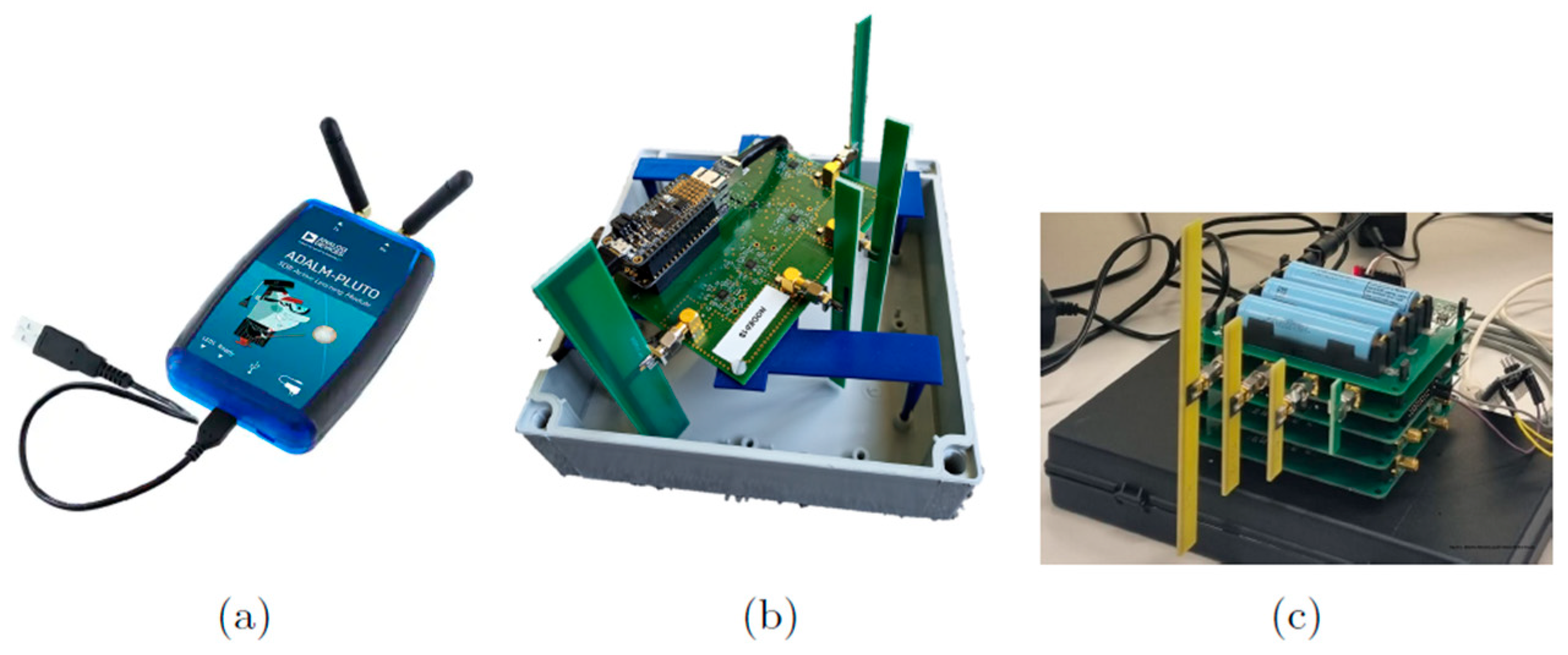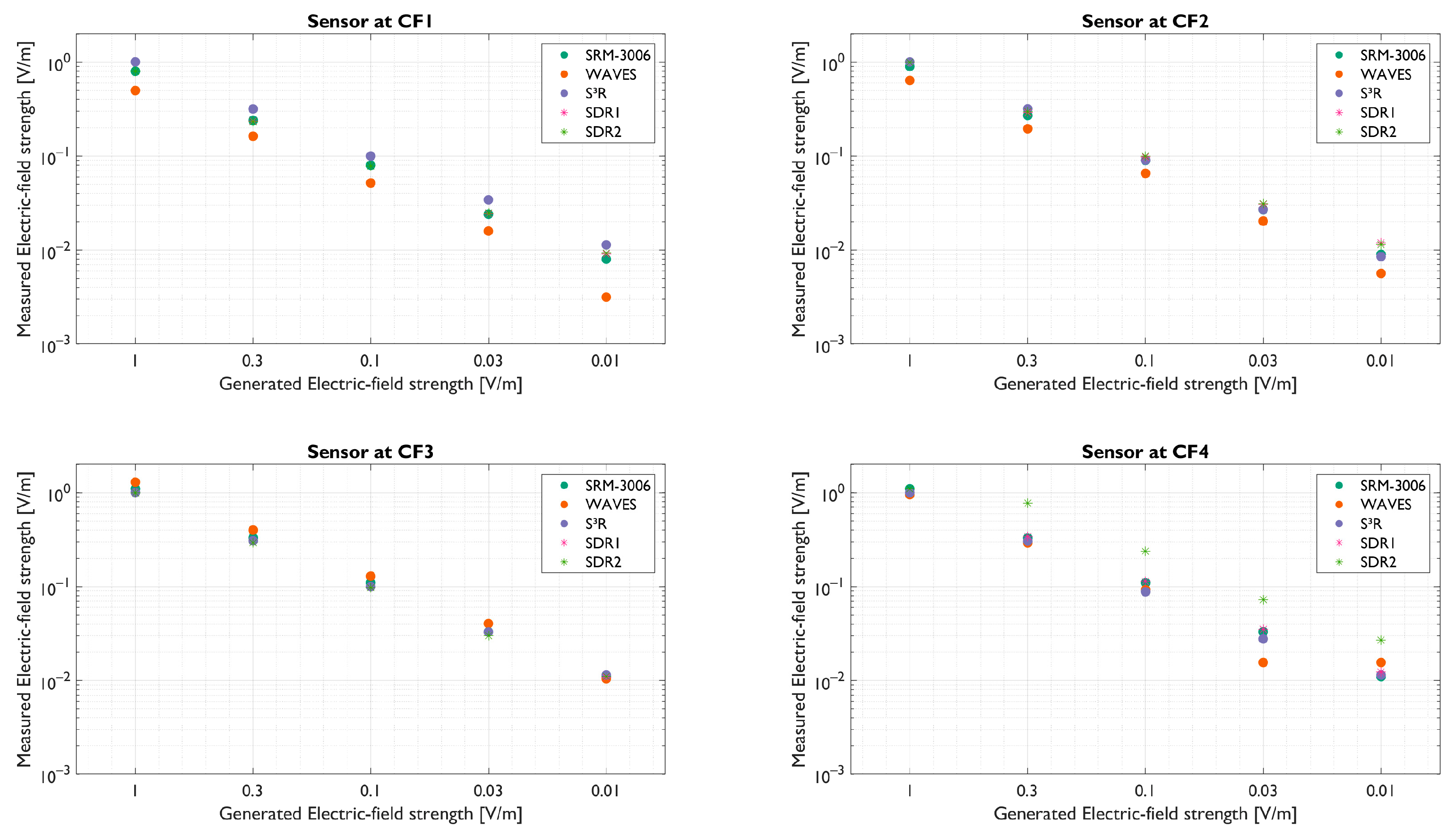Comparison of Low-Cost 5G Electromagnetic Field Sensors
Abstract
:1. Introduction
2. Materials and Methods
2.1. Measurement Equipment
2.1.1. SDR Sensor
2.1.2. WAVES Sensor
2.1.3. Smart Sensor Systems Research (S³R) Group Sensor
2.2. Benchmark Measurement Equipment
2.2.1. Spectrum Analyzer with Tri-Axial Antenna
2.2.2. Field Strength Analyzer
2.3. Gigahertz Transverse Electro Magnetic (GTEM) Cell
2.3.1. Downlink Power Sweep
2.3.2. Uplink Frequency Sweep
2.4. Green Village Setup
3. Results and Discussions
3.1. GTEM Cell
3.1.1. Downlink Power Sweep
3.1.2. Out-of-Band Rejection
3.2. Green Village
3.3. Discussion on the Sensors
4. Conclusions and Future Work
Author Contributions
Funding
Institutional Review Board Statement
Informed Consent Statement
Data Availability Statement
Acknowledgments
Conflicts of Interest
References
- Rizzato, F.; Fogg, I. Quantifying The Impact of 5G and Covid19 on Mobile Data Consumption. Internet 2021, 1, 1–15. [Google Scholar]
- Al-Turjman, F.; Ever, E.; Zahmatkesh, H. Small Cells in the Forthcoming 5G/IoT: Traffic Modelling and Deployment Overview. IEEE Commun. Surv. Tutorials 2019, 21, 28–65. [Google Scholar] [CrossRef]
- Li, S.; Da Xu, L.; Zhao, S. 5G Internet of Things: A survey. J. Ind. Inf. Integr. 2018, 10, 1–9. [Google Scholar] [CrossRef]
- Wang, D.; Chen, D.; Song, B.; Guizani, N.; Yu, X.; Du, X. From IoT to 5G I-IoT: The Next Generation IoT-Based Intelligent Algorithms and 5G Technologies. IEEE Commun. Mag. 2018, 56, 114–120. [Google Scholar] [CrossRef]
- Apostolidis, C.; Manassas, A.; Iakovidis, S.; Samaras, T. Electromagnetic Fields in the Environment: An Update of Monitoring Networks in Europe. In Proceedings of the 2022 3rd URSI Atlantic and Asia Pacific Radio Science Meeting (AT-AP-RASC), Gran Canaria, Spain, 30 May–4 June 2022. [Google Scholar] [CrossRef]
- Aerts, S.; Vermeeren, G.; Bossche, M.V.D.; Aminzadeh, R.; Verloock, L.; Thielens, A.; Leroux, P.; Bergs, J.; Braem, B.; Philippron, A.; et al. Lessons Learned from a Distributed RF-EMF Sensor Network. Sensors 2022, 22, 1715. [Google Scholar] [CrossRef] [PubMed]
- Deprez, K.; Aerts, S.; Thielens, A.; Vermeeren, G.; Martens, L.; Joseph, W. Design of a Low-Cost Modular 5G RF-EMF Exposure Sensor. In Proceedings of the Joint Annual Meeting of the Bioelectromagnetics Society and the European BioElectromagnetics Association (BioEM 2021), Ghent, Belgium, 26–30 September 2021; pp. 421–426. [Google Scholar]
- Korkmaz, E.; Littel, S.; Bolte, J. Development of a low cost sensor network for measurement of 5G-signals in the Netherlands. In Proceedings of the 1st Annual Meeting of BioEM, Nagoya, Japan, 19–24 June 2022. [Google Scholar]
- Aerts, S.; Verloock, L.; Bossche, M.V.D.; Colombi, D.; Martens, L.; Tornevik, C.; Joseph, W. In-situ Measurement Methodology for the Assessment of 5G NR Massive MIMO Base Station Exposure at Sub-6 GHz Frequencies. IEEE Access 2019, 7, 184658–184667. [Google Scholar] [CrossRef]
- Aerts, S.; Deprez, K.; Colombi, D.; Bossche, M.V.D.; Verloock, L.; Martens, L.; Törnevik, C.; Joseph, W. In Situ Assessment of 5G NR Massive MIMO Base Station Exposure in a Commercial Network in Bern, Switzerland. Appl. Sci. 2021, 11, 3592. [Google Scholar] [CrossRef]
- Deprez, K.; Verloock, L.; Colussi, L.; Aerts, S.; Bossche, M.V.D.; Kamer, J.; Bolte, J.; Martens, L.; Plets, D.; Joseph, W. In-Situ 5G Nr Base Station Exposure of the General Public: Comparison of Assessment Methods. Radiat. Prot. Dosim. 2022, 198, 358–369. [Google Scholar] [CrossRef] [PubMed]
- Bolte, J.F.; van der Zande, G.; Kamer, J. Calibration and uncertainties in personal exposure measurements of radiofrequency electromagnetic fields. Bioelectromagnetics 2011, 32, 652–663. [Google Scholar] [CrossRef] [PubMed]
- Bornkessel, C.; Blettner, M.; Breckenkamp, J.; Berg-Beckhoff, G. Quality control for exposure assessment in epidemiological studies. Radiat. Prot. Dosim. 2010, 140, 287–293. [Google Scholar] [CrossRef] [PubMed]
- Van Wijk, A. Welcome to the Green Village; IOS Press: Delft, The Netherlands, 2021; pp. 1–60. [Google Scholar] [CrossRef]
- Koppel, T.; Shishkin, A.; Haldre, H.; Toropovs, N.; Vilcane, I.; Tint, P. Reflection and Transmission Properties of Common Construction Materials at 2.4 GHz Frequency. Energy Procedia 2017, 113, 158–165. [Google Scholar] [CrossRef]
- International Commission on Non-Ionizing Radiation Protection (ICNIRP). Guidelines for Limiting Exposure to Electromagnetic Fields (100 kHz to 300 GHz). Health Phys. 2020, 118, 483–524. [Google Scholar] [CrossRef] [PubMed]





| Position 1 | Position 2 | Position 3 | Position 4 | Position 5 | Position 6 | |
|---|---|---|---|---|---|---|
| Average Deviation (dB) | 0.74 | 1.46 | 1.99 | 1.44 | 2.80 | 2.70 |
| Maximum Deviation (dB) | 1.36 | 2.76 | 3.37 | 2.83 | 5.31 | 5.26 |
Disclaimer/Publisher’s Note: The statements, opinions and data contained in all publications are solely those of the individual author(s) and contributor(s) and not of MDPI and/or the editor(s). MDPI and/or the editor(s) disclaim responsibility for any injury to people or property resulting from any ideas, methods, instructions or products referred to in the content. |
© 2023 by the authors. Licensee MDPI, Basel, Switzerland. This article is an open access article distributed under the terms and conditions of the Creative Commons Attribution (CC BY) license (https://creativecommons.org/licenses/by/4.0/).
Share and Cite
Deprez, K.; Colussi, L.; Korkmaz, E.; Aerts, S.; Land, D.; Littel, S.; Verloock, L.; Plets, D.; Joseph, W.; Bolte, J. Comparison of Low-Cost 5G Electromagnetic Field Sensors. Sensors 2023, 23, 3312. https://doi.org/10.3390/s23063312
Deprez K, Colussi L, Korkmaz E, Aerts S, Land D, Littel S, Verloock L, Plets D, Joseph W, Bolte J. Comparison of Low-Cost 5G Electromagnetic Field Sensors. Sensors. 2023; 23(6):3312. https://doi.org/10.3390/s23063312
Chicago/Turabian StyleDeprez, Kenneth, Loek Colussi, Erdal Korkmaz, Sam Aerts, Derek Land, Stephan Littel, Leen Verloock, David Plets, Wout Joseph, and John Bolte. 2023. "Comparison of Low-Cost 5G Electromagnetic Field Sensors" Sensors 23, no. 6: 3312. https://doi.org/10.3390/s23063312





